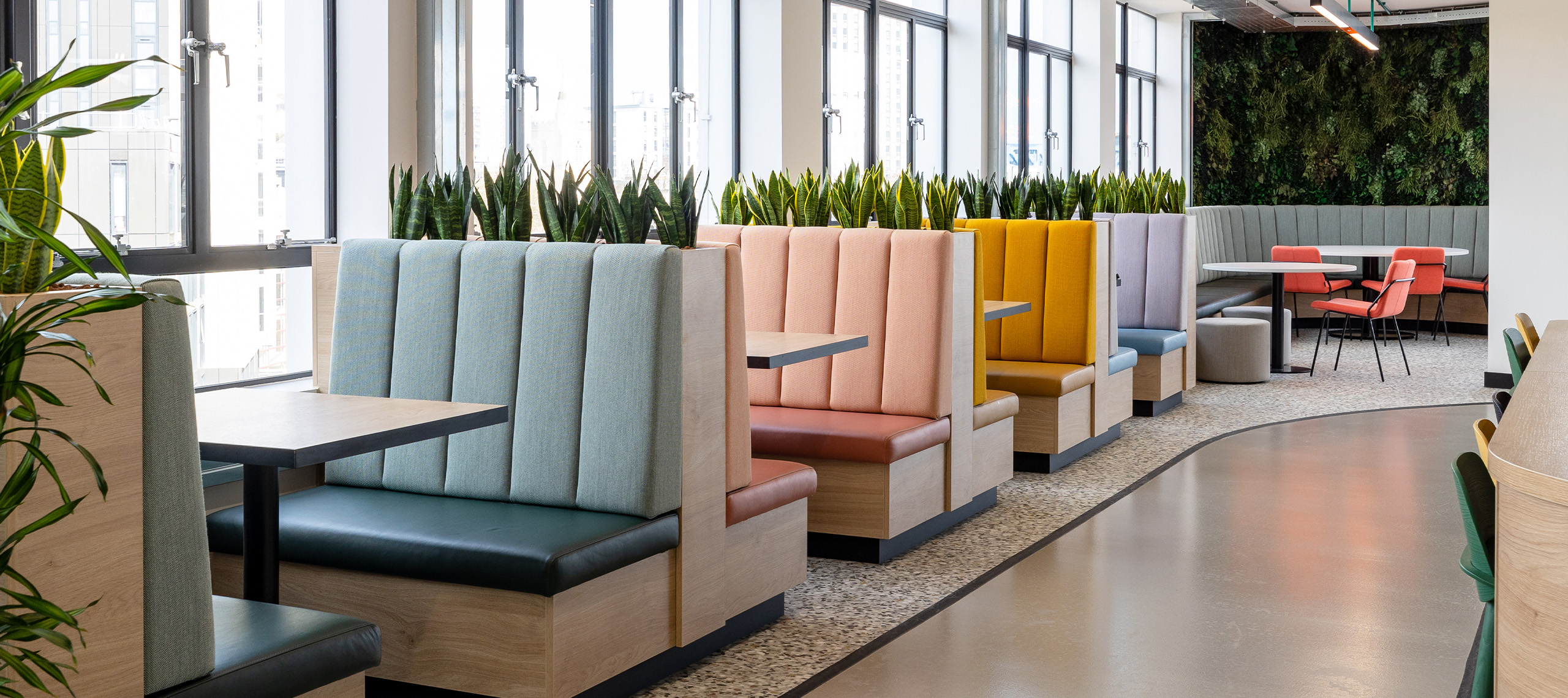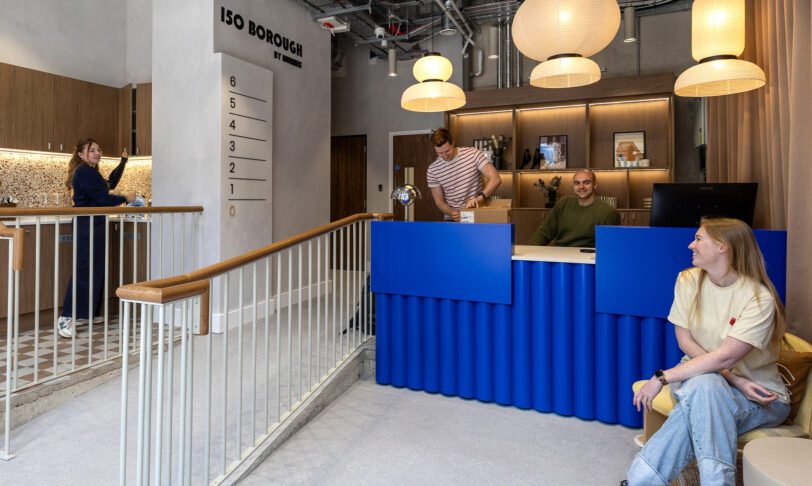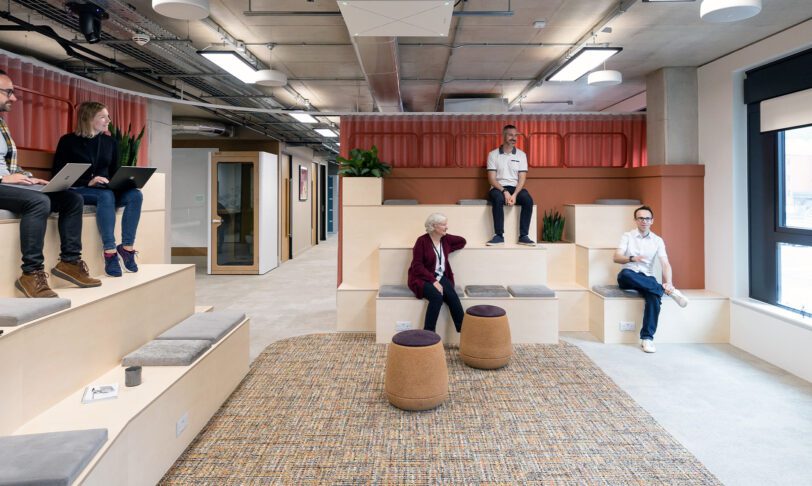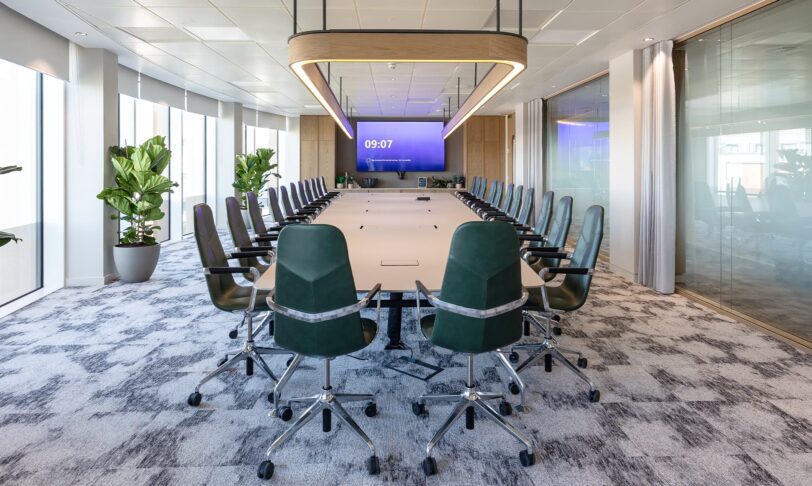Office design strategies for cost-conscious projects
Commercial office design can certainly put pressure on project budgets, particularly as organisations compete to create workplaces that entice people back and support hybrid ways of working. Yet, a high‑performing workspace doesn’t have to come with a runaway price tag; the secret lies in building smart cost control into every stage of the journey.
A skilled Quantity Surveyor acts as the project’s financial compass, translating design ambition into clear spend profiles, challenging over‑specification and doing more than just saving money, but boosting commercial outcomes. The strategies below, shaped by Interaction’s research‑led, people‑first approach, reveal how QS professionals can guide a project from concept to post‑occupancy without sacrificing creativity.
Understanding cost pressures in office fit‑outs
Below are four big‑ticket factors that can quietly inflate a project. By naming them early, a QS can help ensure the entire team stays aligned on priorities and budget. This allows clients to shape a cost plan that protects both the design vision and financial outcomes, with no compromises needed.
Specialist labour premiums
MEP engineers, AV experts and fire‑safety consultants are in hot demand, particularly in larger cities. Because there aren’t enough to go around, their day rates can climb fast. A forward-thinking QS spots these pressure points early and helps clients decide where specialist input is critical, and where a simpler option will do the job just as well.
Material volatility
Since 2023, steel and timber prices have ridden a roller‑coaster, up one quarter, down the next. A QS can help secure orders early or choose materials with more reliable supply chains to stabilise project costs and keep programme dates on track.
Race for quality
Landlords want workplaces that meet modern tenant expectations. That push for premium-grade finishes and smart tech can nudge specs higher than anyone expected. A QS protects the design integrity while guiding specifications toward best-value solutions.
Regulation & ESG
Regulations like the Building Safety Act and ambitious net‑zero targets, mean compliance and carbon tracking now sit centre‑stage. They are good for people and the planet, but they do add cost. A QS ensures these considerations are factored into budgets from day one, avoiding unpleasant surprises later.
Read our guide on designing net-zero offices.
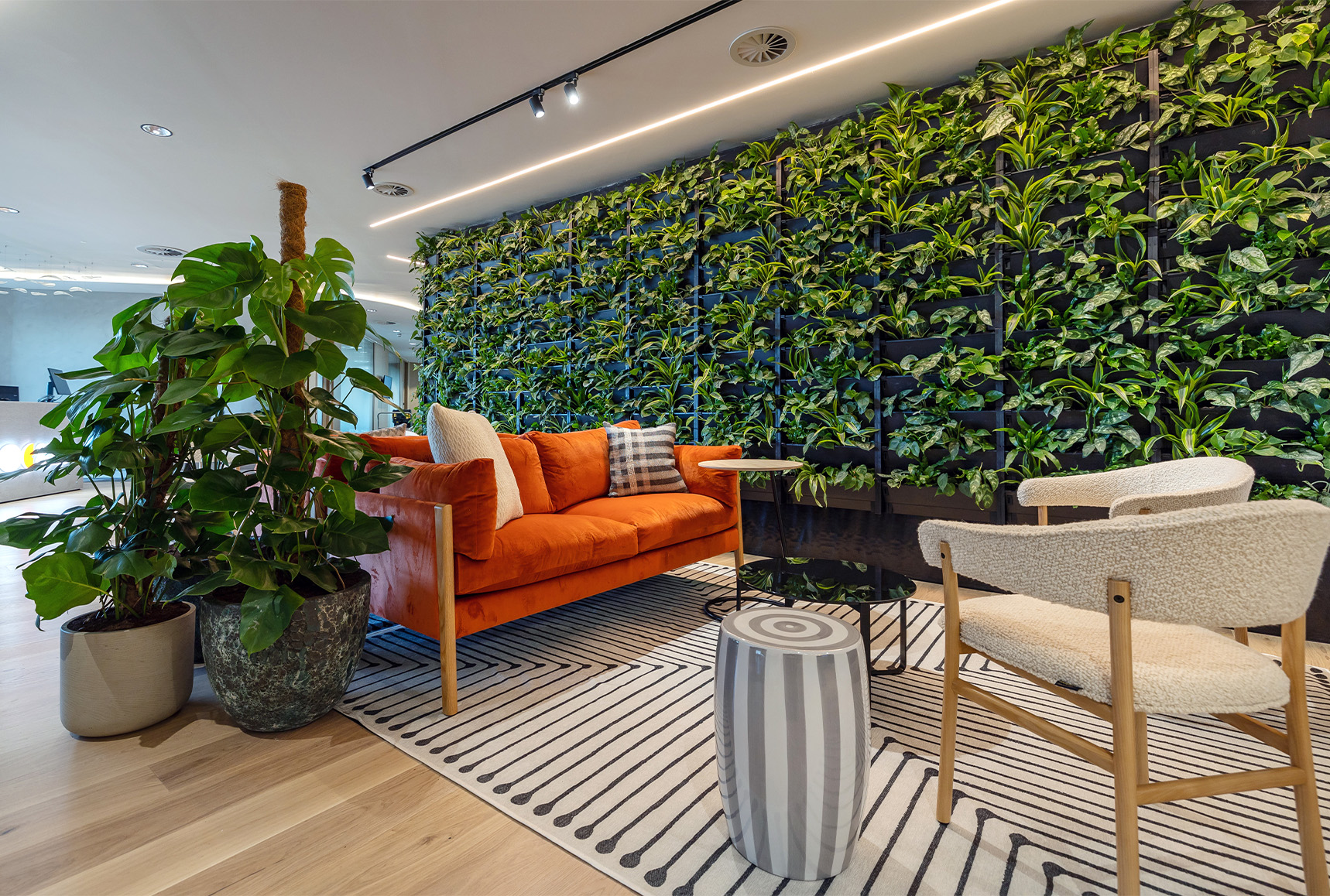
Early-stage cost planning: design-led value control
Bring the QS in from the first sketch
Early involvement means the budget and the brief grow together. A quick chat at the start covers headcount, green targets, and any perks the landlord might be offering. Everyone leaves with a shared, realistic plan.
Match dreams to budgets right away
A QS can provide live cost reviews that turn blue‑sky ideas into clear numbers. For example, choosing a modular reception desk instead of a sculptural one can free up cash for top‑grade acoustic finishes elsewhere, so the office still looks stunning and feels comfortable.
Use speedy cost‑modelling tools
Modern estimating software pulls in up‑to‑date regional rates, inflation data, and benchmark figures. In minutes, you can build a rough cost picture of floors, services, and finishes, showing exactly where the big numbers land. Switching from fixed desks to neighbourhood seating? Curious about the impact of triple‑glazing? Side‑by‑side comparisons reveal it instantly.
Some platforms even link to 3D models, automatically counting doors, lights, and cable trays as the architect tweaks the design. This real‑time feedback allows design teams to iterate freely without losing budget visibility.
Techniques for accurate early cost modelling
Working with an experienced Quantity Surveyor gives project teams access to more accurate forecasting methods. They check prices with trusted trades, add sensible allowances for risk, and run best, worst, and most‑likely scenarios so no one gets caught off guard. By blending real-world data and experience, a QS helps create cost models that clients and design teams can trust from day one.
Cost-effective office design strategies
1. Flexible, multi‑use spaces
Picture a single room hosting an executive board meeting at nine, morphing into a hands‑on training session by lunchtime, and turning into a buzzing town‑hall by four. Sliding walls, fold‑away tables, and stackable chairs help every square metre do double (or triple) duty. A QS can help identify where flexible layouts can reduce overall space requirements without compromising usability, protecting both fit-out and long-term operational costs.
2. Reuse and refresh
Often the smartest move in any office design on a budget is to keep the good bones you already have. A QS can suggest where existing elements, from exposed concrete soffits to reupholstered seating, can be repurposed. Reusing assets keeps project spend low, supports sustainability credentials, and enhances overall asset performance.
3. Choose materials that last
A QS helps clients make informed decisions by comparing whole-life costs. For example, investing in solid-surface worktops may reduce maintenance costs over time, proving more economical than cheaper, short‑lived alternatives.
4. Keep details consistent
Standardising glazing widths, door‑set sizes, and cable‑tray run speeds up installation, wins bulk discounts, and reduces on‑site errors. Consistency supports office space optimisation by trimming both the build schedule and the snag list, which in turn protects programme certainty and keeps revenue flowing. A QS can help implement these strategies while maintaining a tailored look.
5. Sustainable upgrades that pay back
Planet-friendly touches such as LED lighting with daylight sensors or bio‑based acoustic panels offer long-term savings. A QS ensures these features align with green tax incentives and tenant expectations. Greener spaces are proven to lift employee wellbeing and lower utility costs – key drivers for tenant satisfaction and longer leases, making these moves a cornerstone of cost‑effective office design.
Taken together, these cost‑control strategies do far more than cut upfront spend. They protect margins by keeping CapEx and running costs predictable, boost asset performance through lower energy use and easier maintenance, and help landlords attract and keep quality tenants who value thoughtful, sustainable spaces.
Cost-saving case study
Interaction’s six-week fit-out for Civica in Bristol’s Spectrum building shows how smart choices can stretch a budget without clipping ambition.
- High-occupancy, “broken-plan” layout – Instead of carving the 14,600 sq ft floorplate into boxed-in departments, Interaction used curved partitions, collaborative pods and two glass-fronted “Innovation Rooms.” This fluid arrangement packs more people into a smaller footprint while sidestepping the expense of numerous solid walls and doors.
- Space-and-cost optimisation from day one – The brief called for a “cost and space-effective” workplace. By challenging the default grid of square meeting rooms, the design team squeezed extra desks and touchdown areas into the same area, protecting Civica’s long-term occupancy costs.
- Fast-track, in-occupation build – Completing the project in just six weeks while parts of the office remained in use slashed double-rent and staff-disruption costs. Speedy handover also meant Civica could start using the flagship hub and generating value from it sooner.
- On-time, on-budget delivery – A clear cost plan, tight programme control and snag-free hand-over kept unexpected extras off the invoice, safeguarding Civica’s margins.
- Future-proof flexibility – Modular furniture and movable pods let teams reconfigure spaces without expensive re-fit cycles, supporting tenant retention and asset performance over time.
Value engineering without compromising the vision
Value engineering should never feel like wielding a blunt red pen. Instead, it is a chance for the QS to make sure every element earns its keep. The guiding principle? Function over form, without losing the heart of the concept.
Examples:
Consider acoustics. A full plasterboard partition certainly blocks sound, but lightweight acoustic panels paired with heavy curtains can deliver a similar hush while costing and weighing far less. They also leave the layout more flexible for future churn.
Lighting tells a similar story. A one‑off sculptural pendant may turn heads, yet a thoughtfully chosen catalogue LED, fitted with a quality diffuser and smart controls, creates the same ambience, trims installation time, and slashes energy bills.
Floor finishes, too, benefit from function‑first thinking. Instead of bespoke timber parquet, a high‑end luxury vinyl tile can mimic the look, withstand heavier foot‑traffic, and halve maintenance costs.
Crucially, a good QS knows where not to compromise, such as air quality systems or data infrastructure, ensuring ongoing wellbeing and performance.
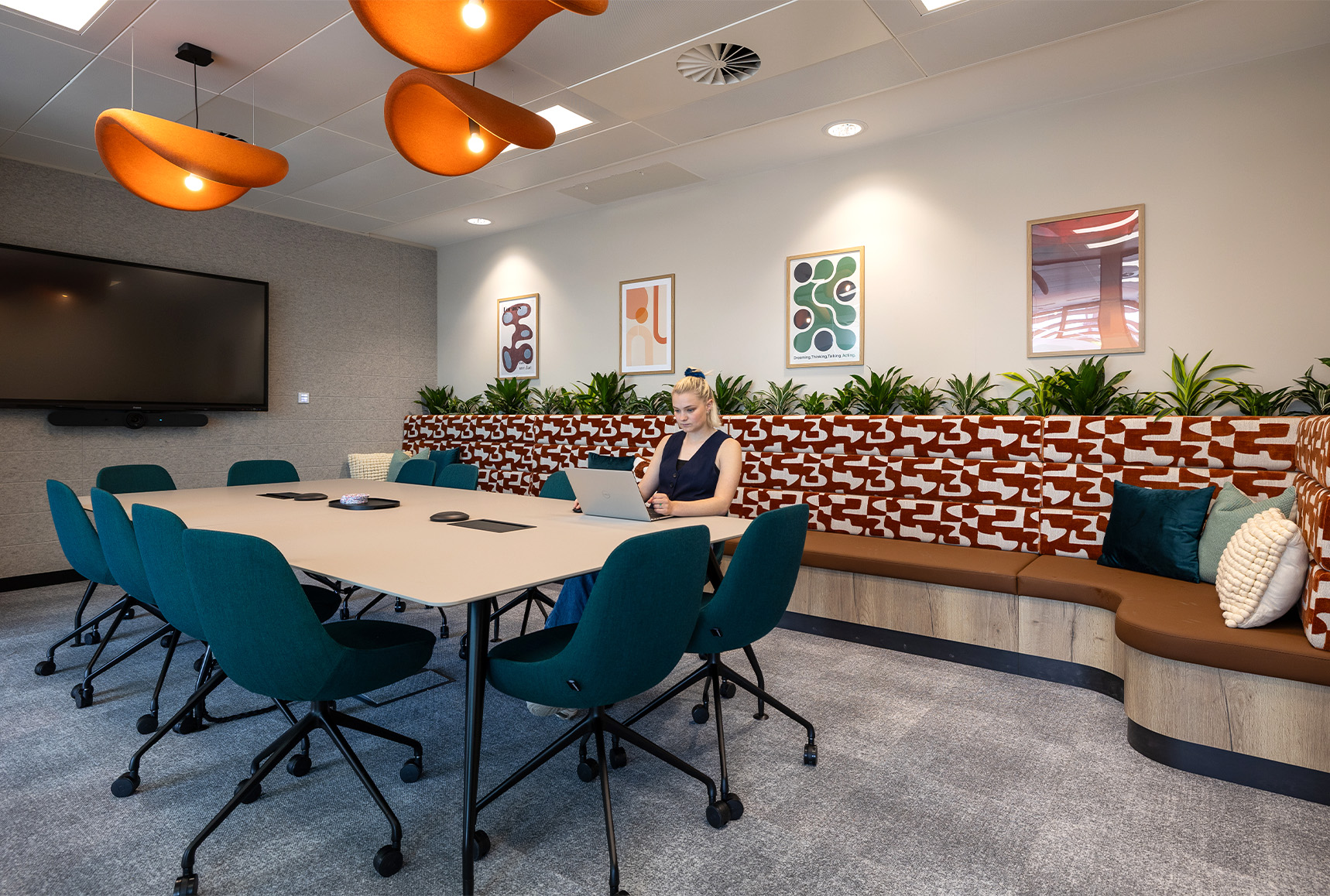
Smarter procurement and fit‑out delivery
A QS supports smarter buying strategies from the outset, turning a good floor plan into a great, efficient office layout. Early collaboration with contractors uncovers risks and identifies efficient build methods while the design is still flexible.
Break down your procurement into clear categories: furniture, technology, and building services like heating, cooling, and lighting. This makes real-time price comparison easier and keeps every pound accounted for. Ready‑made bathroom pods or plug‑and‑play meeting booths arrive finished and tested, shaving weeks off the programme and trimming defect resolution lists.
Project‑tracking apps offer an extra safety net. Each change is flagged instantly with its cost and timeline impact, so the team can resolve minor issues before they snowball. Stick to these habits, and budget-conscious design feels easy rather than stressful.
Tracking ROI and long‑term value
Price per square foot grabs headlines, but the real story unfolds after the welcome party. The value of a cost-conscious office design is in how the space performs. A QS can help evaluate that value by supporting:
- Desk and meeting room usage analytics
- Indoor air quality monitoring
- Smart meter insights for energy-saving systems
- Lifecycle cost comparisons
- Post-occupancy feedback
Together, these hard and soft metrics turn a single line‑item cost into a living ROI story: sharper productivity, happier teams, and spaces that evolve without eye‑watering maintenance bills.
Help in balancing cost and design
Some fit-outs may seem costly, but a proactive QS sees this as an opportunity to add value. By embedding cost thinking into every design conversation, championing flexible spaces, durable materials, and smarter procurement, they protect budgets without compromising creativity. The result is a workplace that engages employees and satisfies the finance team long after move‑in day.
Want a workspace that balances ambition with budget? Get in touch with Interaction today, and let’s create a cost‑effective office that works brilliantly for your people and your bottom line.
